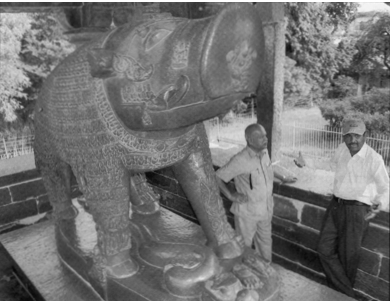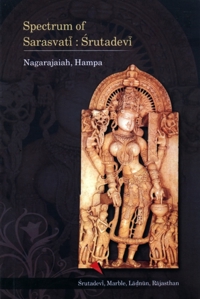It is believed that the two rivers Gaṅgā and Sarasvatī merge, and bathing at their confluence is meritorious. Sarasvatī river had seven aliases of Suprabhā, Vimalodā, Kāñcanākṣī, Viśālā, Mānasahṛdā, Suveṇū and Oghavatī, all of them meet at Saptasārasvata-tīrtha [Mahābhārata 9: 37: 27]. Further more anecdotes are narrated apropos Vasisṭha, Viśvāmitra, and Sarasvatī. She also manifested herself in anthropomorphic form to Śvetaketu and Tārkṣya. Along with various gods, and goddesses, shown on the body of Viṣṇu's Varāhāvatara, third among incarnations, Sarasvatī figures appropriately on the mouth of Varāha Boar's monolithic image at Khajurāho (10th cent.).
|
Contemplating on pan-Indian tendencies of making images of Sarasvatī in the Hindu, Buddhist and Jaina pantheons, Catherine Ludvik, with her extensive researches on the theme[*], suggests two possibilities of Sarasvatī's feminine form: 1. the Mahābhārata narrative details, 2. Or, the other way around 'the female figure of Sarasvatī in the epic (Mahābhārata) might conceivably have been inspired from already existing, but no longer extant or known to be extant, representations of her' [Ludvik 107]. Thus the origin of Sarasvatī's iconographic conceptualization goes back to the third century bce. From then on gradually her human-like representations developed in the three different religions of the Hindu, Buddhist and Jain.
Vedābnāṁ mātaraṁ paśya matsthāṁ.
'Behold goddess Sarasvatī, the mother of Vedas enshrined in me' says Nārāyaṇa to Nārada [Vyasa's Mahābhārata, 12: 326: 5.].
Sarasvatīha vāgbhūtā śarīram te pravekṣyati
Sarasvatī enters the body as speech - [supra 12: 306: 6.]
jihvāyām vāk Sarasvatī
Sarasvatī dwells in the tongue [- ibid 12: 231: 8.].
devī jihvā sarasvatī
'goddess Sarasvatī is (your) tongue' says Bhīṣma, in veneration of Viṣṇu - [supra 6: 61: 56.].
parama jinendra-vāṇiye Sarasvatī
the supreme Lord Jina's preaching is Sarasvatī - [Pampa, Ādipurāṇa, 1-16.].
The Mahābhārata has referred to Sarasvatī as vāc [12: 306: 6] and vaṇī [3: 132: 2].
Besides, her beautiful form and lovely celestial body is lauded [3: 184: 18].
rūpaṁ ca te divyam atyanta kāntam
She is the daughter of Brahma alias Prajāpati and grand daughter of Pitāmaha alias Brahma; wife to Manu [Mbh 5: 115: 14]. Curiously, she is depicted as wife of sage Matināra to whom she bears a son called Taṁsu [Mbh 1:: 9: 26]. She also figures as the surrogate mother to Sārasvata. Purāṇas narrate Sarasvatī as consort of Brahma (Prajāpati); 'the union of the father with his daughter remains a sin, both in human and in celestial eyes' [Ludvik 121]. However, corresponding literary sources describing Sarasvatī as daughter - consort of (father-husband) Brahma abound in Indian languages.
"Sarasvatī. Riverine Goddess of Knowledge. From the Manuscript-carrying Vīṇā-player to the Weapon-wielding Defender of Dharma" - Catherine Ludvik
Review by Pye, Michael (Marburg / Kyoto, May 2009), Marburg Journal of Religion, ISSN 1612-2941
 Prof. Dr. Nagarajaiah Hampana
Prof. Dr. Nagarajaiah Hampana

